Espacios. Vol. 36 (Nº 02) Año 2015. Pág. 4
Solid waste management web-based database system in brazilian seaports
Sistema de base de datos basada en web para la gestión de residuos sólidos en puertos marítimos brasileños
Clarice Neffa GOBBI 1,2; Thiago Duarte MOTA 1; Carlos Roberto Bastos Araújo FILHO 1; Maria José de O.C. GUIMARÃES 2; Marcos Aurélio Vasconcelos de FREITAS 1.
Recibido: 15/09/14 • Aprobado: 25/10/14
Contenido
ABSTRACT: |
RESUMEN: |
1. Introduction
In Brazil, the Law No 12.305/2010, which created the National Policy on Solid Waste (Política Nacional de Resíduos Sólidos - PNRS), brings together a set of principles, objectives, instruments and guidelines for an integrated solid waste management in the country, being the product of an extensive discussion and strong institutional coordination involving the three federal agencies (federal, states and municipalities), the productive sector/private institutions, non-governmental organizations and the civil society. The PNRS must be incorporated by all generators of solid waste, legal entity, public or private, that generate solid waste through their activities, being one of its key objectives the order of priority for waste management, which ceases to be voluntary and shall be compulsory: no generation, reduction, reuse, recycling / solid waste treatment and environmentally appropriate disposal of waste.
In this context, seaports are major generators of solid waste. The volume of solid waste concentrated in Brazilian ports, resulting from various onshore and offshore activities, is very significant, since the amount of cargo handled is large. In Brazil, ports handled 928.4 million tons of cargo in 2013, a 2.65% growth in comparison with the previous year (Portal Webportos, 2014). The proper management of port waste, in accordance with the National Policy on Solid Waste, is fundamental for the sustainable development of port activities in the country.
However research is needed to adequate the management of waste in ports with the legislation in order to establish the practical implementation of the National Policy on Solid Waste (PNRS), since several waste management failures still occur in most Brazilian ports (MMA, 2011).
Thus, the Compliance Program of Solid Waste and Liquid Effluent Management in Brazilian Seaports, which is an initiative created by the Secretariat of Ports of the Presidency (SEP/PR) and implemented by the International Virtual Global Change Institute (IVIG/COPPE/UFRJ) was initiated in 2010 to overcome this need, among other objectives.
The Compliance Program of Solid Waste and Liquid Effluent Management in Brazilian Seaports includes 22 Brazilian ports and displays as the first phase of the project the development of quantitative and qualitative diagnosis of solid waste generated in ports, in order to know the generation profile of each port, first step towards the realization of an efficient planning of waste management.
The project used the academic literature, official documents of port authorities and fieldwork to diagnose the solid waste generated in ports and vessels, as well as management information held in each port for solid waste (identification, quantification, frequencies of generation, forms of packaging, destination).
Among the obstacles found at the Brazilian ports by the project, the most relevant were the practices related to the control and generation of the information regarding waste management issues, including quantitative and qualitative data of generated waste.
Little information was available for virtual access and in many cases the information was not recorded in any database. Also, in many cases the existing database were incomplete and without standardization. Parallel to this, much information was in paper sheets handwritten without any standardization in the nomenclature used for the types of waste, vessel names, company names and units of measure for quantifying waste. In many cases the information is not even studied, in order to manage and publish an evaluation of a port.
This non-uniformity in relation to information is a serious impediment to the overall understanding of waste generation in a port, as well as to propose solutions.
Without standardization is not possible to perform a comparison between the data, for example for different months (seasonality) in the same port or different ports. Consequently, the development of research and studies on this subject is negatively affected.
This scenario is seriously harmful to the management of solid waste, since the control and the generation of information related to this management is fundamental to know the profile of waste generate in a port and thus, to be possible to elaborate solutions and decision-making relating to an efficient waste management (SEP/PR and UFRJ, 2013).
So, create a structured system to be able to document, to archive and to make available technical documents and information about the waste management infrastructure of the Brazilian ports is an important and relevant issue. This kind of investment will help to report information between research institutions and to study ways to reach the principles and objectives of the Law No 12.305/2010 (PNRS).
The web has a signficant impact on all aspects of our society, from business, education, government, entertainment sectors, industry and our personal lives (Garousi et al., 2013). The main advantages of adopting the web for developing software products include (1) no installation costs, (2) automatic upgrade with new features for all users, (3) universal access from any machine connected to the Internet and (4) being independent of the operating system of clients (Dogan et al., 2014).
Therefore, the main objective of this work consists on the presentation of a tool for electronic registry, considering the amount of information, the complexity and the dynamics of the variables and their interaction. This web-based database system tool was developed to enable a normalized information and control of solid waste generation from various port areas. This information requires a very great control, documentation, archiving, and high investment in human, logistic and financial resources. The combination of the computer technology of internet and the registration system facilitates the integration of data from each of the ports, being its intent to find a single standard protocol for all entries received. In this way, the digital media can become an effective tool to support and control. It is important to emphasize that the web-based system was developed for the port area, including common areas not leased, leased areas and vessels.
2. Methodology
In 2011, Santos and co-workers developed a web-based waste inventory system (Chemical Management Information System - CMIS) for chemical and hazardous waste in accordance with Philippine government regulations using PHP language programing and MySQL database to manage, control and provide information such as safety data sheets; tracking system using barcode stock-levels monitor, consumption rates, movement and expiration dates and other applications. That system was created to facilitate the inventory, purchase, storage, waste management and disposal of chemicals, providing multi-level access and support the reporting requirements to government agencies.
The web-based system presented here is being developed to reach a matured and similar system to that one developed by Santos et al. (2011) allowing in the future, the management and control of solid waste generated in port areas. The system is being created using the languages programming C # DOT NET, Ajax and SQL Server database.
As manager of WEB applications, the IIS (Internet Information Services) was used and as the system version controller was used SVN Tortoise software, being also used the database SQL Server 2008 R2, Microsoft manufacturer. The WEB server was needed to make the system available for use in the field, through a microcomputer DELL Server type, with Windows 2003 Server operating system, network card 10/100 Ethernet 3COM, connected through the internet network of an outsourced company (Synapsis of Brazil LTDA), with support 24 hours a day and 7 days a week.
In all methods for database construction, various equipment and methodologies were used like Scrum 15 days interval methodology and tools for creating diagrams using DBWrench. The Visual Studio 2010 program was used to develop "web sites" for the system in C # dot net. Thus, the entire system was designed for web environment, being able to be accessed through computers PCs, tablets, phones, or cloud computing. As the project management tool, DOT Project version 2.1.3 was used and the project manager PMP certified as a member of PMI (Project Management Institute).
All access to the system created can be done by any device that has access to the internet with a web browser (Mozilla, Chrome, Internet Explorer or another browser on the Internet).
Initially, a registration protocol was set for data collection at Brazilian Ports. With these protocols determined, the structures of the database were created for each of the input points needed to build the system. Entries protocols served to map the needs of each port, what they have in common, and thus create the tables and relationships in the database. This material created was generated by programming language C # dot net (Asp net), with Ajax and made available in Hyper Text Markup Language (HTML) format. To improve the feasibility through the process, and reduce file manipulations at the operating system level, the codes were adapted to VBA within the Excel environment. Visual Basic for Applications (VBA) is an implementation of Microsoft's programming language Visual Basic that enable building user-defined functions (UDFs), automating processes and other functionalities through dynamic-link libraries (DLLs). It can be used to control many aspects of the host application, including manipulating user interface features, such as menus and toolbars, and working with custom user forms or dialog boxes (Bovey et al., 2009).
To make this material available was necessary to create a safety mechanism that does not allow other users to access the content. This mechanism was developed in C # dot net (Asp net) with JavaScript / Ajax, where users must be registered before entering any of the items. Thus, each of the ports shall have an insight into their own space, not being allowed to see the results of other ports, while access to the University and the Secretariat of Ports allows evaluating all.
The system was developed using the information contained in the documents stored by the Port Administration known as Manifests of Transport and Waste Inventories. That information were analyzed, adapted, systematized and validated with field activities before digitally recorded in the system and gave rise to the tables and relationships of the system.
The Manifest of Transport is a document, usually regulated by local or state environmental secretary, in compliance with federal resolutions, requiring registration of the activity and of the transportation of solid waste.
The Waste Inventory is the monthly summary of waste handling. This document is generated by leased terminals or subcontractors providing services within the port area. The purpose of this document is to enable the Port Administration record the result of the inspection on the removal of waste from the ports. The paper also consists on the compilation of the information in the Manifests of Transport generated within 30 days. However, it was identified that some terminals only deliver annual inventories.
For a better understanding, the Figure 1 shows a graphic illustration of the diagram of entities and relationships for the system operation.
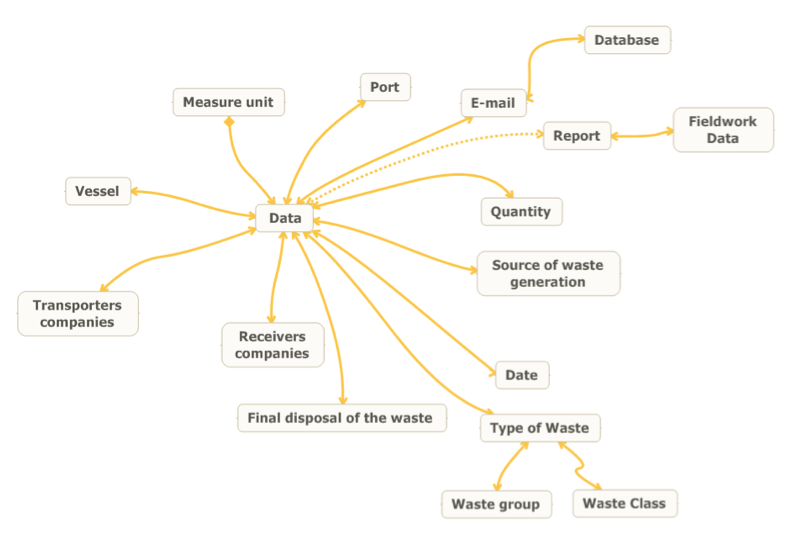
Figure 1 : Graphic illustration of the diagram of entities and relationships for the system operation.
3. Results and discussion
The inclusion of information related to the port solid waste management is held by people previously registered in each of the 22 ports by the VBA/Excel described at the methodology. The user logs into the system using a password and fill forms for inserting data that are sent by email to the system, which automatically recognizes and stores the data in the system format.
The forms for insertion of data includes the information related to solid waste management, such as:
- Name of the port
- Source of waste generation
- leased areas (name the leasing company)
- non-leased areas
- vessels (vessel name)
- Type of waste
- Date of the output of the waste from the port (day, month, year)
- Amount of waste and its respective measure unit (kg, m3, unit)
- Name of the companies responsible for the logistics of the residue (transporters and receivers)
- Final disposal of the waste (landfill, incineration, recycling).
All items above are pre-registered in a closed form (Figure 2), i.e., the user must choose names previously registered, not having the ability, for example, to create different nomenclatures for the same residue or change the mode of measurement of the waste. The insertion of data through a closed form guarantees the importation of the information in a standardized and uniform way. With this assurance of uniformity of information the data can be analyzed, monitored and compared with different periods or ports, for example, for reporting and specific research. New names of vessels or leased areas, types of waste and companies can be registered in the system only by the manager of the system.
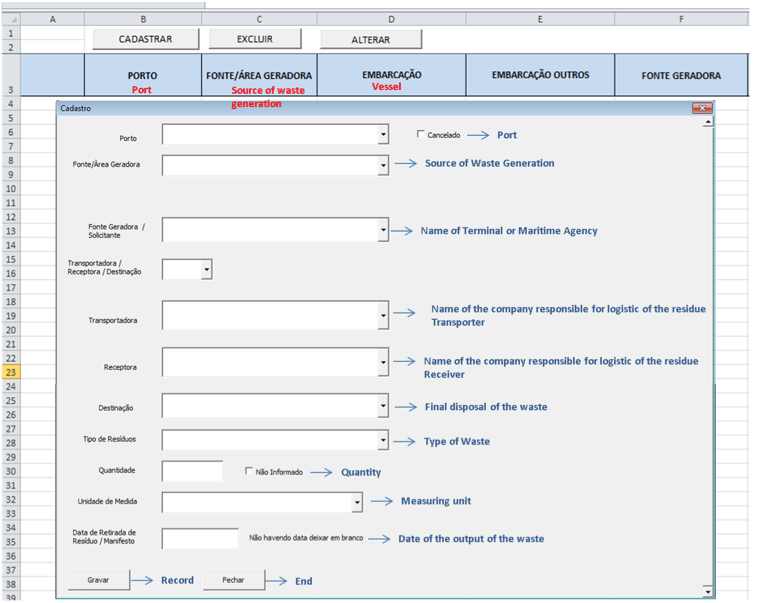
Figure 2: Example of the closed form.
In addition to registered users for data entry, there are also users registered for obtaining / viewing data. It is important to highlight that each user may be able to view only a particular set of data or all data from a specific port, data from a group of ports or even all data related to all 22 ports. After logging in, the system displays the modules that the user has access, being three modules the maximum exhibited (Report, Analysis Report and Percentage Graphic Report).
The Report module allows the user to select the port, the period (day, month and year of the start and the end of the period) and the type of waste of interest. After selection, the system makes the search in the database and make available to download in excel format the complete data of quantities and their units per day (in the selected period), source of waste generation (areas not leased, leased areas and vessels), transporters companies, receptors companies and final disposal. This file is the most complete of the modules and may be worked out for specific user studies.
The Analysis Report module allows the user to select the port and the type of waste of interest. After selection, the system makes the search in the database and displays the total amount of waste type selected per month of each year, without distinguishing the source of waste generation. Thus, it shows the total amount of the port in general. These data are presented in bar charts.
Relative to the Percentage Graphic Report module, it allows the user to select the port, the year and the source of waste generation (leased area, not leased area and vessels). After selection, the system makes the search in the database and displays the percentage of each type of waste throughout the year selected, without distinguishing between the different months. These data are presented in pie chart.
In the map option, it is possible to view the geographic location of the ports, as shown in the Figure 3. When navigating through the system, moving the mouse over the desired port, it is possible to check the existing georeferenced data about solid waste.

Figure 3: Geographic location of the ports in the system.
Thus, the system is capable of generating reports, charts and performs various data combinations and intersections, according to the interest and needs of the person who is handling it. This information may be essential to implement support decision making for the management of port solid waste, as an indication of the need for certain infrastructure, among others.
The following six Brazilian Seaports allocated in different regions were randomly selected for comparison of their waste typological profiles by source of waste generation, as illustrated in Figure 4. Three scenarios were created using as references three sources of waste generation: non-leased areas, leased areas and vessels.
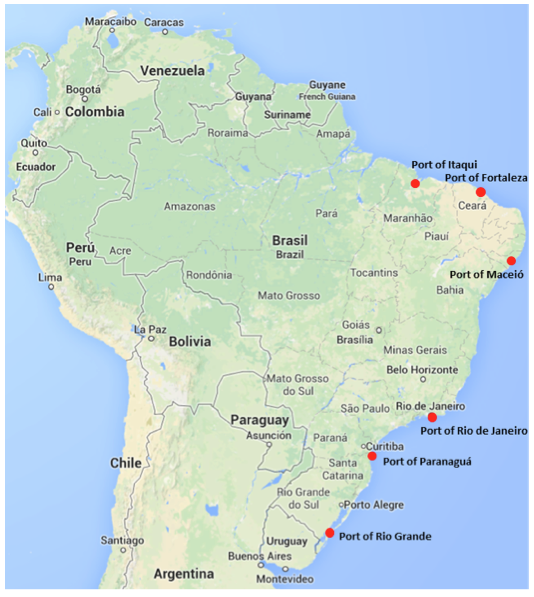
Figure 4: Selected ports for the three scenarios.
The first scenario was established between four ports (Itaqui, Fortaleza, Maceió and Rio de Janeiro) relative to the wastes from non-leased areas for the period between the years 2011-2013 (Figure 5).
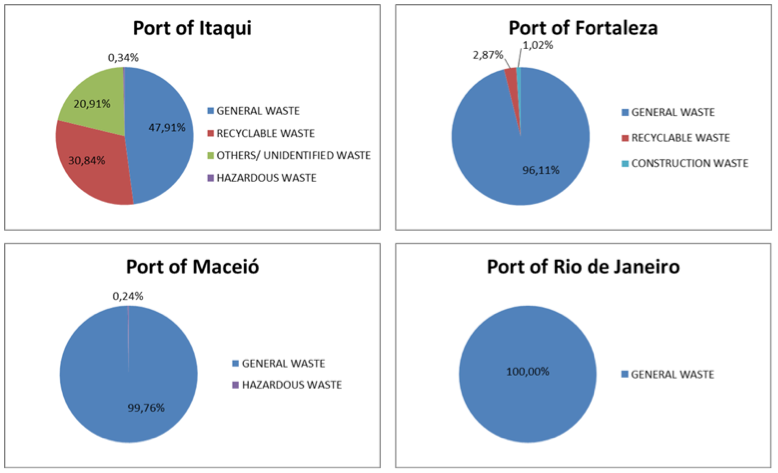
Figure 5: Waste typological profiles by non-leased areas, for the period between the years 2011-2013.
It is possible to observe in Figure 5 that the Ports of Fortaleza, Maceió and Rio de Janeiro have a general waste generation above 90% in their areas not leased, indicating a fault or even the absence of processes of segregation and recycling collection of generated waste. This fact reveals a nonconformity regarding the best practices in waste management and the precepts of the National Policy on Solid Wastes (PNRS), since possibly many materials, even with potential for reuse and more environmentally appropriate destination, are being disposed in landfills. Landfills, according to the PNRS, should be the last resource used for disposal of waste, when there is no more possibility of waste treatment.
In contrast, the Port of Itaqui shows that the waste management of their non-leased area has a best implemented segregation and recycling collection of solid wastes, when compared to the other three ports, generating approximately 48% of general waste and 31% of recyclable waste. The Port of Itaqui presented a portion of approximately 21% of unidentified residues, suggesting the need for improvement in the identification process of their solid waste management.
The second scenario was established between four ports (Fortaleza, Rio de Janeiro, Paranaguá and Rio Grande) relative to the wastes from leased areas, for the period between the years 2011-2013 (Figure 6).

Figure 6: Waste typological profiles by leased areas, for the period between the years 2011-2013.
As can be seen in Figure 6, the Port of Fortaleza, in relation to the waste from leased areas, showed a very high generation of general waste (86.83%). The generation of recyclable waste was only 2.55%. This indicates, again, a possible nonconformity regarding best practices in waste management and the precepts of the National Policy on Solid Wastes (PNRS). Materials with potential for reuse and more environmentally appropriate destination, could are being disposed in landfills, treated as refuse, instead of materials.
The Ports of Rio de Janeiro and Rio Grande had a low generation of general waste, 0.68% and 1.71% respectively, and percentages of 14.8 % and 34.54 % for recyclable waste, indicating best practices of segregation and recycling collection, when compared to other ports in this scenario. It was possible to verify that these two ports showed high percentages of construction waste (over 40%), indicating that these ports have recently undergone a process of physical expansion by achievement of works of civil engineering.
Still for the Port of Rio de Janeiro, it was possible to detect a generation of approximately 20% of unidentified residues, suggesting the need for improvement in waste management area in relation to the identification of waste generated.
The Port of Paranaguá showed a significant percentage of recyclable waste (52.1%), indicating to have a good practice of waste segregation and recycling collection in its leased areas. But even with more than 50% of recyclable waste, showed 37.17% of general waste, a relatively high percentage when compared to the Ports of Rio de Janeiro and Rio Grande, in this scenario.
The third scenario was established between five ports (Itaqui, Fortaleza, Rio de Janeiro, Paranaguá and Rio Grande) relative to the wastes from the vessels that docked in the port, for the period between the years 2011-2013 (Figure 7).
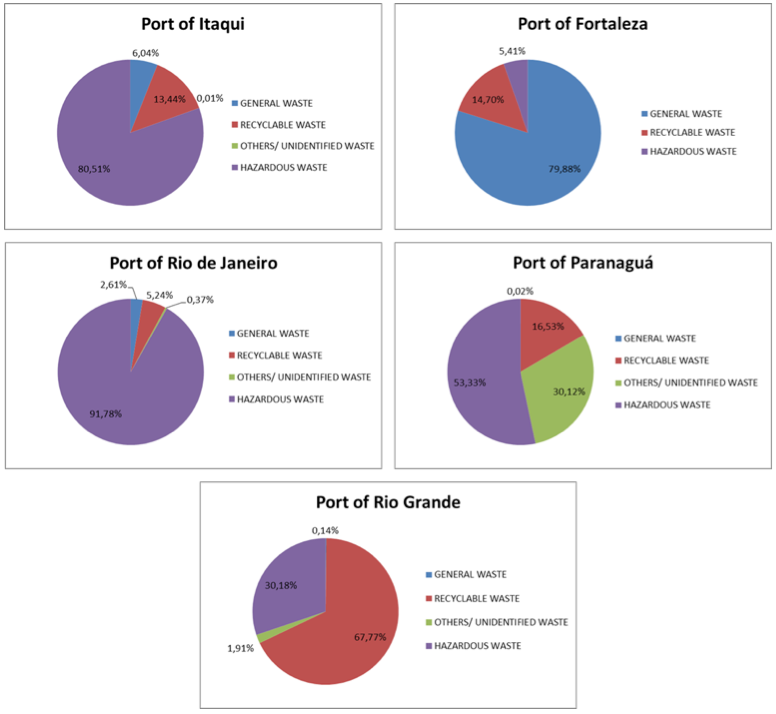
Figure 7: Waste typological profiles by vessels, for the period between the years 2011-2013.
It was observed in Figure 7 that in this scenario the portion of hazardous waste is much higher when compared to the other scenarios. This is because a large volume of waste vessel refers to oily residues.
The only port in this scenario that diverges from the others was the Port of Fortaleza, with a percentage of about 80% of general waste (while the others had no more than about 6%) and a relatively low percentage of hazardous waste compared to the others (5.41%, while all others showed above 30%).
In this scenario, the Port of Paranaguá showed a generation of approximately 30% and unidentified residues, suggesting the need for improvement in the waste management area in relation to the identification of waste generated.
This scenario showed that most of the waste removed from the vessels of the Ports of Itaqui and Rio de Janeiro were related to hazardous waste, with percentages above 80%. This result can be related, at the Port of Rio de Janeiro, with the large traffic of vessels supporting offshore oil platforms.
It is important to highlight the significant portion of recyclable waste removed from the vessels at the Port of Rio Grande. The vessels of this port removed more than 60% of recyclable waste, while the portions of recyclable waste removed from the other ports in this scenario did not exceed approximately 17%.
4. Conclusion
The irregular economic growth does not conceal the central role of the port sector in global logistics and in the expansion of international commerce. About 90% of world commerce is done through the international maritime transport industry, which is essential to world economy (Darbra, 2014). For most world ports, the volume of maritime cargo has significantly increased, leading to the expansion of port installations and the creation of new wharfs, deeper channels and modern facilities (Alderton, 2005). The improvement of port facilities and their operations aid the growth of maritime transport, the economic development of coastal countries and the generation of jobs. However, port operations and activities can also have negative consequences and impact the environment if environmental management is not done correctly (Darbra, 2014).
Included in the issue of environmental management, there is the waste management. The proper management of port waste from ships, port operations and administrative areas is essential to control and eliminate risk situations for port operators and local population since waste present risks for the environment and human health.
At the Project named Compliance Program of Solid Waste and Liquid Effluent Management in Brazilian Seaports, conducted in partnership by the Secretariat of Ports of the Presidency (SEP/PR) and the International Virtual Global Change Institute (IVIG/COPPE/UFRJ), it was found that the solid waste management in many Brazilian ports has not been entirely implemented yet, in spite of international conventions and environmental and health surveillance laws. It was observed that several flaws and deficiencies still occurring regarding waste management in ports. Among these, the most relevant are the failures related to the practices of control and generation of information (quantitatively and qualitatively), as well as practices related to elaboration and updating of databases. In many cases the information about the waste generated in the port was never been even studied or analyzed, in order to develop and publish an evaluation of a port.
This scenario is seriously harmful to the management of waste, since the organization and updating of information are essential for knowing the profile of waste in a port and in this way, to evaluate and outline integrated solutions for the improvement of the waste management. Thus, to overcome this situation should be constituted as the main challenge towards the adequacy of the country's ports. Once overcome this bottleneck, it will be possible to face more complex issues.
From this finding, it was observed the need for the elaboration of a system, on a national scale, that could be used as an effective tool to overcome the deficiency found and could reach the demands of environmental managers and other professionals related to the solid waste management. In this process, there was the challenge of aggregating data from different sources and with different qualities, in order to import the information in a fully and uniformly way. It is worth mentioning that an efficient port waste management benefits the commercial competitiveness of Brazilian ports, as European ports have already overcome this issue (Jaccoud and Magrini, 2014).
The system presented in this work aims to enable an automatically control through electronic registration, that can be held with any device like tablet, mobile phone or even using cloud computing instead the use of paper filed records. This web-based database system tool considers the amount of information, the complexity and the dynamics of the variables and their interaction. Thus, the data regarding waste management of the Brazilian port areas could be recorded in a standardized manner into a single shared database.
It is important to highlight that this tool aims to assist the adequacy of the Brazilian ports to the National Policy on Solid Waste (PNRS), which includes integrated solutions and use of landfill only as a last resort, when there is no possibility of treatment. The evaluation of several consecutive years, in addition to enabling the creation of a more extensive time series and therefore more reliable, enrich seasonal quantitative analysis, important for planning effective management, as well as for the preparation of the Plan of Solid Waste Management of the port, required by the Law 12.305 / 2010 (PNRS).
In addition, the higher amount of cargo to be handled by Brazilian ports, which was predicted by Alderton (2005) and Darbra (2014), will lead to an increase in port activity and an accelerated growth of solid waste generation. Consequently, the implementation of tools to aid the improvement of the waste management process with the proper monitoring of the waste generation and control of this information will become more urgent for port administrations.
Although the present system is not fully complete yet, since the data from previous years are still being recorded in the database, it is already possible to realize the advantages of the system developed through the results and indicators derived from the application of this technology. The system is important to carry out monitoring studies that follow the evolution of waste management in ports, to collect primary data that may aid the decision making regarding waste management for procedures and necessary infrastructure, and to organize studies which take into account different possibilities for final destination, as the energetic use of waste.
5. Acknowledgment
We would like to thank the Secretariat of Ports of the Presidency (SEP/PR) for all the support, providing all necessary information for the success of this work.
6. References
Alderton, P. 2005. "Port Management and Operations". London: Informa Maritime & Transport.
Bovey, R.; Wallentin, D.; Bullen, S. and Green, J. 2009. Professional Excel Development: The Definitive Guide to Developing Applications Using Microsoft Excel, VBA, and .NET. The Addison-Wesley Microsoft Technology Series, Second Edition.
Brasil, 2010. Law Nº 12.305, August 2, 2010. Establish the National Policy on Solid Waste; amending Law Nº 9.605 of February 12, 1998; and other measures. Available at: http://www.planalto.gov.br/ccivil_03/_ato2007-2010/2010/lei/l12305.htm
Darbra, R. M. 2014. "Identification and selection of Environmental Performance Indicators for sustainable port development". Marine Pollution Bulletin, 81: 124–130.
Dogan, S.; Betin-Can, A.; Garousi, V. "Web application testing: A systematic literature review". The Journal of Systems and Software, 91: 174 – 201, 2014.
Garousi, V.; Mesbah, A.; Betin-Can, A.; Mirshokraie, S. "A systematic mapping study of web application testing". Information and Software Technology, 55: 1374–1396, 2013.
Jaccoud, C. and Magrini, A. 2014. "Regulation of solid waste management at Brazilian ports: Analysis and proposals for Brazil in light of the European experience". Marine Pollution Bulletin, 79: 245-253.
MMA – Ministério do Meio Ambiente, Governo Federal (Ministry of Environment, Federal Government). Plano Nacional de Resíduos Sólidos (National Solid Waste Plan). Brasília, September of 2011. Available at: http://www.cnrh.gov.br/pnrs/ Access: 10/2013.
MySQL; http://www.mysql.com/ [Access: April 25, 2014].
Santos, J.E.R.; Alfonso, F.N.N.; Mendizabal Jr., F.C.; Dayrit, F.M. "Developing a Chemical and Hazardous Waste Inventory System". Journal of Chemical Health & Safety. November/December, 15-18, 2011.
SEP/PR and UFRJ. Guia de Boas Práticas Portuárias (Best Practices Guide for Ports) - Programa de Conformidade do Gerenciamento de Resíduos Sólidos e Efluentes Líquidos nos Portos Marítimos Brasileiros (Compliance Program of Solid Waste and Liquid Effluent Management in Brazilian Seaports). Secretaria de Portos da Presidência da República - SEP/PR (Secretariat of Ports of the Presidency - SEP/PR), 2013.
1 IVIG/COPPE/UFRJ – International Virtual Institute for Global Changes, Federal University of Rio de Janeiro, Rio de Janeiro - RJ – Brazil.
2 EQ/UFRJ – Chemistry School of the Federal University of Rio de Janeiro, Rio de Janeiro – RJ – Brazil.
Corresponding author: Clarice Neffa Gobbi Postal address: Universidade Federal do Rio de Janeiro, Cidade Universitária, Ilha do Fundão, Centro de Tecnologias. Av. Pedro Calmon, S/N, Bloco P-P2, Rio de Janeiro/RJ. CEP: 21.941-596 Email: claricegobbi@ivig.coppe.ufrj.br